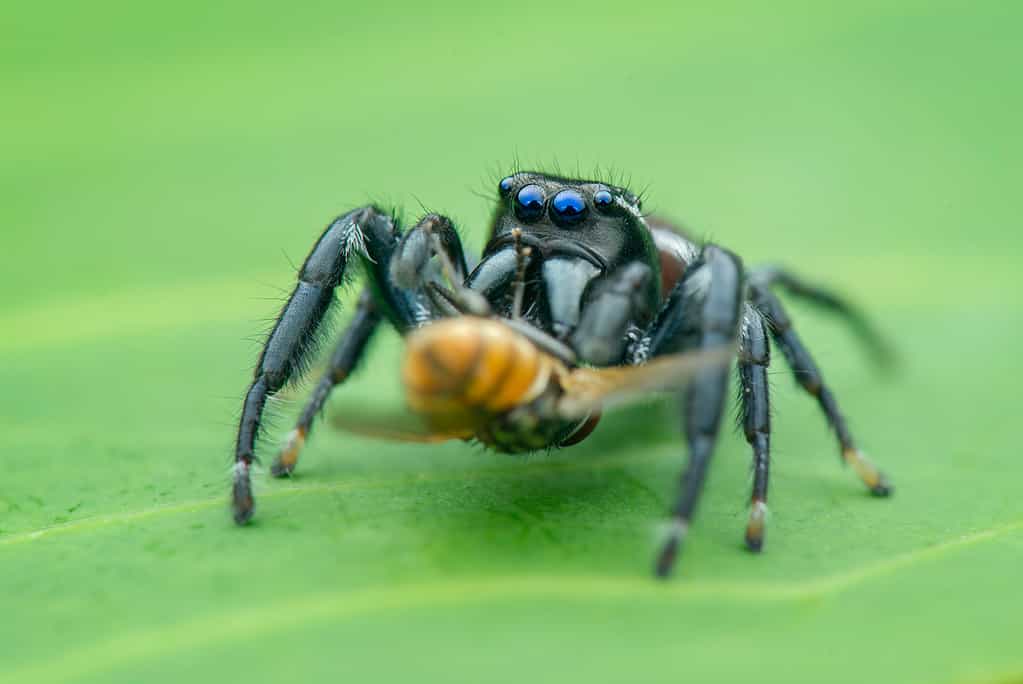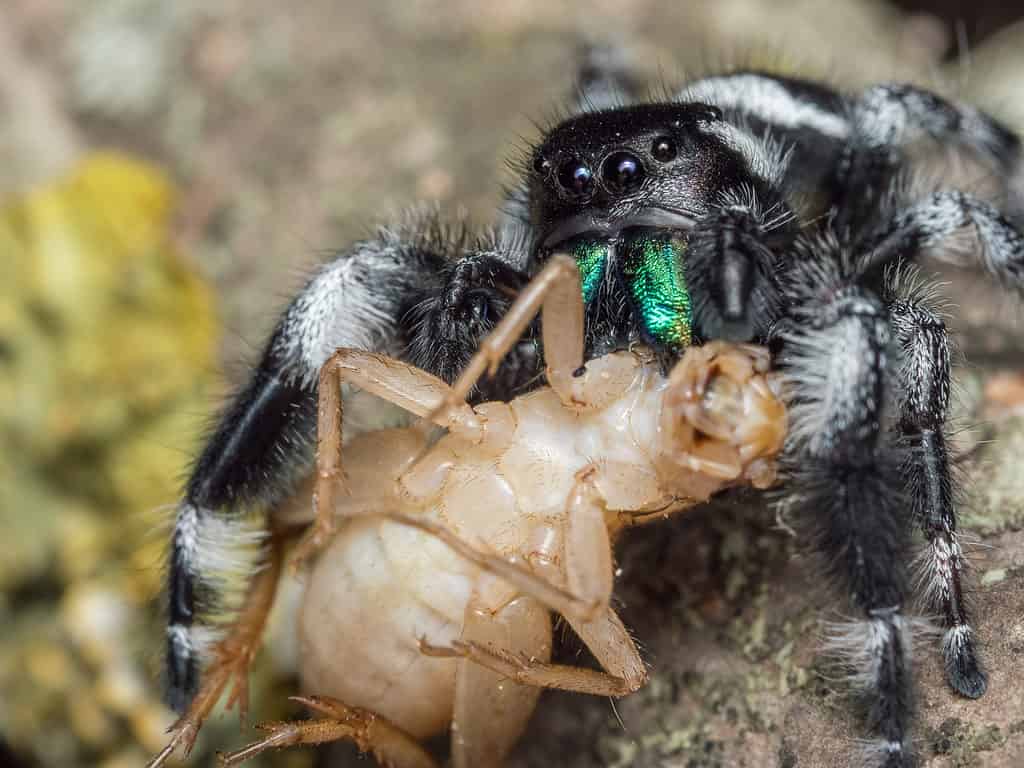
The post A Tiny Jumping Spider Quickly Takes Down a Mealworm appeared first on A-Z Animals.
Everyone loves the world’s most famous jumping spider, Lucas. While we’ve seen this adorably animated arachnid dance, sing, and play, there’s one more thing he’s capable of: eating. The jumping spider in this YouTube video is just like Lucas, but you’d never guess he’s a skilled hunter. The mealworm never stood a chance against the speedy spider, especially when the spider uses its acrobatics to subdue much larger prey. The hunting habits of jumping spiders make them one of the most fascinating arachnids in the world.
Jumping Spiders Are Skilled Hunters
For such small arachnids, jumping spiders have a mighty appetite. They are carnivorous and eat most insects, including those that are 1.5 times their size. They enjoy a varied diet and eat a range of insects, including crickets, flies, cockroaches, moths, mealworms, aphids, small beetles, and grubs. Anything that crawls in the dirt or flies in the air is fair game, as long as it’s catchable. Some species also prey on other spiders, especially those that are smaller or slower-moving. Jumping spiders are not scavengers; they actively hunt and catch their food. They have no interest in carrion or prey that’s already dead. They may avoid insects that are likely to fight back and win, such as those with hard shells. Insects that are prone to biting or venomous are challenging, as they can easily get the upper hand on the small arachnid. However, jumping spiders are opportunistic and may take their chances anyway.

©Paul Reeves Photography/Shutterstock.com
There are more than 4,000 species of jumping spiders, all of which share the same basic features. Their eyes are the most prominent feature. These large eyeballs on the forehead help locate and track prey. The smaller eyes on the top of the spider’s head track peripheral movements. This makes them adept hunters with eyesight that surpasses that of most insects. Jumping spiders can see a range of colors and are particularly sensitive to shades of green and ultraviolet light. This further enhances their vision, allowing them to distinguish between prey and other species.
The Deathly Dance of the Jumping Spider
Its vision isn’t the only thing that helps it locate and trap prey. Jumping spiders can move their bodies in ways that set them apart from other arachnids. Their long legs are more powerful than they look, and they can move faster than the human eye can track. Their small size allows them to be agile while remaining undetected, creating the perfect tiny predator. In the wild, these spiders are far more menacing to small insects than the average house pet.

©DWI YULIANTO/Shutterstock.com
Jumping spiders do not create webs, meaning they must hunt regularly. When they find an insect they want to eat, they begin by observing. Once they’re confident in their meal choice, the spider uses its silk to anchor itself. This is called a dragline, which functions as a tether for the spider. Then, it jumps onto the prey below. These spiders use the element of surprise to stun prey, which typically works in their favor. These spiders are incredibly intelligent; if their first attempt to catch prey fails, they use their silk tether to quickly retreat to safety. This highly acrobatic display is a testament to the evolution of such a small arachnid. This YouTube video showcases the speed at which a jumping spider can capture prey, even without the advantage of high ground.
A Surprisingly Venomous Bite
Many people may not be aware that jumping spiders have a venomous bite. Their venom is medically insignificant to humans, and they are considered non-venomous. A bite from a spider of this size would feel similar to a mosquito bite. However, this is not the case for the insects that jumping spiders prey on. Similar to most arachnids, jumping spiders use their venom to immobilize their prey. Their venom contains digestive enzymes that break down the tissue and organs of an insect. When this venom is injected, it takes effect quickly, liquefying the insect.

©iStock.com/Macrolife.it
This has benefits for juvenile jumping spiders that require small insects that are easily digested. For mature adult spiders, a liquid diet prevents them from expending unnecessary calories while eating. In short, a liquid diet benefits most spiders by eliminating the need for chewing and making digestion easier. Young jumping spiders are typically fed every 2-3 days, while adults may hunt or be fed every 3-7 days. During their molting phase, jumping spiders are more vulnerable and may avoid pursuing large prey. In captivity, jumping spiders rely on being fed by their human handlers. It is possible to overfeed a spider, and the most significant sign of this is bloating. In extreme cases, an overfed jumping spider can have mobility issues or rupture its abdomen.
The post A Tiny Jumping Spider Quickly Takes Down a Mealworm appeared first on A-Z Animals.
June 17, 2025 at 05:02PMLianna Tedesco
.jpeg)
.jpeg)

0 Comments